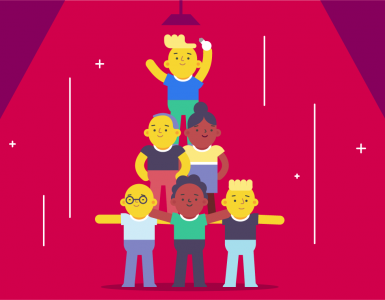The period from which a person joins an organization to the time they leave can be termed as employee life cycle. Every organization’s success level can be greatly impacted by the advancement or lack of its staff members through the stages of their employee life cycle.
Rather than viewing employee engagement efforts as a rare event only brought up when workers feel down or disengaged, the employee life cycle model treats it as a planned experience woven into every employee’s trajectory in the organization. It helps to encourage high employee engagement, productivity, and better collaboration that leads to perpetuity and success and should be ingrained in every company’s culture.
In this article, we’ll go over the different stages of the employee life cycle and explain what you should do to encourage your employee’s success during each phase.
What is the employee life cycle?
Employee life cycle is an organizational strategy for visualizing how employees interact with the company in which they work. The employee begins as a new hire and progresses through various stages of growth and development. They become more experienced and take on more responsibility as they move ahead. Eventually, they reach the end of their career stage and retire or leave the company.
The employee lifecycle divides a company’s employee experience into seven stages: attraction, recruitment, onboarding, development, retention, separation, and advocacy. By understanding the various stages of the cycle, you can play a more active role in encouraging employees to reach their full potential.
What are the stages of the employee life cycle?
The employee life cycle refers to the many phases an employee experiences while working for a company. You may wonder what the different stages are and what to expect in each stage. Don’t worry. We’re here to break it down for you.
The attraction stage
When a company is looking to hire new employees, it is in the attraction stage. This is where the talent acquisition manager’s skills are tested. They need to be able to find the best candidates and entice them to join the company.
The manager needs to sell the company and its benefits. During this stage, they need to know what the company is looking for in a new employee and create a positive impression of the company, so the candidate will be interested in finding out more.
They also need to be able to assess the candidate’s qualifications and see if they are a good fit for the company. If they are not, the manager should let them go.
For example, a company considering hiring a DevOps engineer would filter out potential candidates based on their general knowledge about cloud computing and more technical skills with the specific software or tools the company is using.
The shift to remote work has introduced several new challenges in this employee lifecycle stage, but it has also opened up a world of new opportunities. For businesses, one of the biggest advantages of remote working is attracting top talent from around the globe.
For employees, it’s now easier to stay in touch with potential employers and recruiters. Social media platforms like LinkedIn are great ways to connect with recruiters and build professional relationships. The benefits exceed the technological advancement of workplace chat tools that help remote teams around the world communicate and collaborate more efficiently and easily. Furthermore, tools like LinkedHelper can enhance your LinkedIn experience by automating certain tasks, such as connection requests and follow-ups, streamlining your networking efforts, and increasing your visibility in the professional community.
The recruitment stage
This is the stage where the employer begins the process of finding new employees. It can be lengthy and expensive, but it’s ultimately worth it. This stage aims to find the best possible candidates for the job.
HR is responsible for recruiting new employees and screening them for the job. They also need to make sure that the candidates are a good fit for the company. If not, they need to be able to identify that and refer them to other positions within the company.
Once the candidates are shortlisted, it is time for the interview. The HR manager has to be well-prepared and ask relevant questions to help make the right decision.
HR assistance is essential at this stage because it helps set the tone for the rest of the employee’s life cycle. Using an applicant tracking system allows to find suitable candidates and get them on board quickly to ensure smooth sailing for the rest of the cycle.
Recruiting remotely has emerged as a great challenge for many HR teams. Communication between managers and hiring personnel on different channels can be difficult to manage and properly organize. A tool like Chanty helps with this process by allowing them to have real-time group conversations and share files with each other while tracking important notes before the hiring process begins. It also allows teams to quickly access previous data points so they can compare candidates efficiently.
The onboarding stage
Once the decision is made, it is important to onboard the new employee well. This includes providing them with all the necessary information so that they can start working productively as soon as possible. During this time, they will receive training on company policies and procedures as well as their specific job duties.
HR should to follow this onboarding process checklist to make sure that the process is smooth and efficient, as this will set the tone for the rest of the employee’s time with the company. If the onboarding process is difficult or confusing, it is more likely that the employee will become disengaged and may even leave the company.
During this stage, it is also important to get to know the new employee and understand their goals and objectives. By doing this, you can match the employee with the right team and projects, which will help them succeed in their new role.
A good way to onboard your employees efficiently is to use collaboration tools that make the process smoother and easier. For example, Chanty offers unlimited searchable chat history that helps new employees catch up with what has been done in the past easily.
The developing stage
In the developing stage, employees are still getting to know their colleagues, the company culture, and the expectations of their role. They are also working on building the skills and knowledge necessary to be successful in their position.
You need to provide support and guidance to help employees settle into their new roles. It is also crucial to allow employees to ask questions and receive feedback. Providing employees with the resources they need to be successful at this stage will help them feel more confident and engaged in their work.
That’s why communication is key here, especially in the remote work environment. Fortunately, there are a number of tools that can help remote team stays connected. One popular option is Chanty, a chat platform that features group chats, video calls, and file sharing. It helps employees stay on top of their work tasks and offers a wide range of collaboration features, including task management and a Kanban board.
The retention stage
This is the stage when an employee is fully settled into the company and their role. They are engaged with and committed to the organization. The goal during this stage is to keep the employee happy so that they will want to stay with the company for a long time.
There are a few things that can be done to encourage retention:
- Offer competitive salaries and benefits: This will help to keep your employees from looking for other opportunities.
- Foster a positive work environment: This includes open communication, respect, and collaboration. Consider employee experience software to implement these goals and improve employee satisfaction.
- Offer development opportunities: Employees who feel they are constantly learning and growing are more likely to stay with a company.
- Be flexible: Employees appreciate employers who are willing to be flexible with things like hours and working from home.
It is also the stage where the employee is under a lot of pressure to keep their performance and productivity up. A recent study showed that even people in the IT industry, which is said to have the best working conditions, experience a lot of stress connected to their work. Fortunately, supporting employees’ mental health and general well-being is becoming more popular.
The separation stage
Separation is the last stage of the employee lifecycle. In this stage, the employee leaves the organization, whether it is through retirement, termination, or resignation.
Separation can be a difficult time for both the employee and the employer. HR needs to handle this stage with care, as it can be a sensitive time. They should conduct an exit interview and work with the employee to ensure a smooth transition and help them with any questions.
An even better solution would be to use project management tools such as Chanty which already have multiple integrations and allow all the data storage to be automatically available at all times.
When an employee leaves the organization, it is crucial for HR to debrief with their team. They should find out what worked well and what could be improved for future employees. This feedback can improve the employee life cycle and make it more successful for everyone involved.
Alumni and advocacy stage
They are former employees who have left the company but want to stay in touch with it via social media or other means.
Alumni programs help maintain those connections by sending out periodic updates about what’s going on at your company and offering exclusive discounts to alums.
Why is the employee life cycle important?
The employee life cycle is an essential guide for helping companies maximize returns on their investment in human capital. It provides value not just to HR departments but to all of those who interact with or depend upon your business’s human resource systems, giving everyone a clear picture of how they fit into your operations as well as today’s larger workplace landscape.
By understanding the importance of the employee life cycle, businesses have a better idea of how to manage their talent pipeline effectively and create a culture of growth for their employees over time.
Ultimately, a company’s success lies heavily on its ability to analyze its people strategies regularly in order to keep up with changing trends and enhance operational efficiency. Investing in an efficient employee life cycle is beneficial for both employees and employers alike, as it could lead not just to increased financial gains but also to improved job satisfaction amongst staff members. This can significantly reduce turnover rates while also ensuring that high-quality employees remain in the workforce for the long term.
Employee Life Cycle metrics you should track
As an employer, you should track key performance indicators to ensure your employees are productive and happy.
The employee life cycle metrics are one of the most important aspects of your workforce that you need to monitor to improve your hiring process, training program, and overall employee retention rates. By tracking these metrics, you’ll be able to identify areas where your employees may be struggling and make the necessary changes to improve the situation.
Let us take a look at some of the employee life cycle metrics that you should keep an eye on
- Recruitment metrics: Tracking the time it takes to fill a position, the number of interviews conducted, and the number of applicants.
- Onboarding metrics: Measuring the time it takes to get a new employee up to speed, retention rates during the first 90 days, and satisfaction levels.
- Training and development metrics: Tracking the time and cost of training per employee, effectiveness of training programs, and the time it takes to attain competence.
- Performance management metrics: Quality of work, efficiency levels, customer satisfaction.
- Retention and turnover metrics: Measuring employee tenure, voluntary turnover rates, and reasons for leaving.
- Promotion: Tracking the time it takes to promote an employee, the number of promotions, etc.
- Salary: Measuring average salary by position and department, percentage of salary increase/decrease per promotion/departure.
These metrics will give you valuable insights into how your employees are doing at each stage of the employee life cycle and can help you identify areas where your employee experience could be improved.
To achieve the desired results, one has to understand how to track employee life cycle metrics properly, and this doesn’t have to be complicated by the use of an applicant tracking system.
- Engagement: This can be done by surveying employees regularly and asking questions about their job satisfaction, motivation, and commitment to the company.
- Retention: This metric can be tricky to measure, but it’s important to know how long employees stay with the company and why they might leave. One of the most common ways of tracking retention is by calculating the turnover rate.
- Productivity: This can be done by monitoring the number of tasks completed or hours worked over time. You can also ask employees to complete regular self-evaluations to get feedback on their productivity levels.
Final thoughts on employee life cycle
There are a lot of different employee life cycle metrics, but these are some of the most important ones to pay attention to. Tracking them is crucial for understanding your workforce and ensuring your employees are happy, supported, and have what they need to do their best work.








